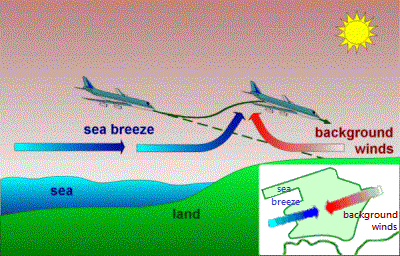What’s Sea Breeze and Land Breeze?
NWS JetStream – The Sea Breeze (weather.gov)

Sea breeze and Land breeze are kind of convective current
Day time 地球吸熱是greenhouse effect
Night time 地球放熱是radiation cooling
The sea breeze circulation is composed of two opposing flows; one at the surface (called the sea breeze) and one aloft (which is a return flow). These two flows are a result of the difference in air density between the land and sea caused by the sun’s heating.
The sun warms both the ground and ocean at the same rate. However, since the ground’s heat remains confined to the top few inches of soil it radiates back into the atmosphere warming the air. As the air warms, its density decreases creating a weak low-pressure area called a “thermal low” (1).
Over the adjacent water the cooler, more dense air, being pull down by gravity, begins to spread inland (2).
This inland push of air from the ocean undercuts the less dense air over land forcing it to rise (3). A sharp boundary develops due to the large difference between the air temperature over land and over water. This boundary, called a sea breeze front, acts in the same manner as the cold front we typically experience.
For example, the air temperature drops significantly after the sea breeze front passes a location, sometimes as much as 15-20°F (8-11°C). The skies also clear after the sea breeze front pass by. Another change that takes place with the passage of the sea breeze front is an increase in humidity. Finally, there can be a significant change in wind direction and/or speed.
Over land, air forced up by the sea breeze front will begin to cool. This cooling means the density increases again forming a small area of high pressure (4). Typically, this occurs from 3,000 to 5,000 feet (1,000 to 1,500 meters) in elevation. At this level the air pressure and density, being greater than the same elevation over the water, causes air to flow back over water (5).
Once over water again, the air cools, increases in density and sinks toward the earth’s surface (6). This enhances high pressure near the ocean’s surface (7) and the whole process repeats as land flowing air pushes the sea breeze front further inland. While the sea breeze is generally associated with the ocean, they can occur along the shore of any large body of water such as the Great Lakes.

Land breezes can occur when the land’s nighttime temperature is less than the sea surface temperature. They are most common during the fall and winter seasons when water temperatures are still fairly warm and nights are cool. However, unlike the sea breeze, the land breeze is often much weaker.
At night, the land temperature falls to below that of the ocean resulting in an increase in the air’s density. Gravity’s downward pull moves air downhill spilling it onto the water (1). This denser air undercuts the lighter, warmer air over the water (2) forcing it up into the atmosphere (3). This rising air forms a weak low-pressure area (4).
The rising air accumulates aloft forming an area of higher pressure (5). Relative to the land at the same elevation, air flows back toward land from high pressure to low pressure (6). Once back over land, the air cools, increases in density and then sinks causing an increase in density and high pressure (7). Gravity pulls the dense air offshore again completing the circulation.
Land breezes are weaker than sea breezes but not because of the difference in heating. Daytime heating and nighttime cooling occur at about the same rate so the potential for both land and sea breezes to be the same strength exists. But at night,
- The cooling ground inhibits vertical motion which, in turn, weakens the land breeze circulation,
- Nighttime cooling also produces a shallower change in temperature so land breeze circulation is shallower, and
- Terrain, vegetation, and buildings inhibit the flow of air from land to water.
How sea breeze affects airport operations?

點解香港daytime 通常用Runway 25 for TKOF and LDG? (i.e Where is the headwind blowing from?)
In other words, nighttime usually use RWY07~
Sea breeze usually develops under fine weather and light wind conditions. At the Hong Kong International Airport, the onset of sea breeze is typically characterized by winds turning westerly over the western part of the airport. With prevailing easterly winds blowing in the background, significant windshear may develop along the runways.
Calendar
| S | M | T | W | T | F | S |
|---|---|---|---|---|---|---|
| 1 | ||||||
| 2 | 3 | 4 | 5 | 6 | 7 | 8 |
| 9 | 10 | 11 | 12 | 13 | 14 | 15 |
| 16 | 17 | 18 | 19 | 20 | 21 | 22 |
| 23 | 24 | 25 | 26 | 27 | 28 | 29 |
| 30 | ||||||
Archives
- November 2025
- October 2025
- September 2025
- August 2025
- July 2025
- June 2025
- May 2025
- April 2025
- March 2025
- January 2025
- December 2024
- November 2024
- October 2024
- September 2024
- August 2024
- July 2024
- June 2024
- May 2024
- April 2024
- March 2024
- February 2024
- January 2024
- December 2023
- November 2023
- October 2023
- September 2023
- June 2023
- May 2023
- April 2023
- March 2023
- July 2022
- May 2022
- April 2022
- August 2021
- April 2021
- March 2021
- February 2021
- December 2020
- November 2020
- October 2020
- September 2020
- August 2020
- July 2020
- June 2020
- May 2020
- April 2020
- March 2020
- February 2020
- January 2020
- December 2019
- September 2019
- June 2019
- May 2019
- April 2019
- March 2019
- February 2019
- January 2019
- December 2018
- November 2018
- October 2018
- July 2018
- June 2018
- May 2018
- April 2018
- March 2018
- February 2018
- January 2018
- December 2017
- November 2017
- October 2017
- September 2017
- June 2017
- March 2017
- January 2017
- December 2016
- August 2016
- July 2016
- June 2016
- May 2016
- April 2016
- March 2016
- January 2016
- December 2015
- November 2015
- October 2015
- September 2015
- March 2014
- September 2013
- August 2013
- March 2013
- September 2012
- August 2012
Categories
- AFTC training
- AGK – Airframe, Engine, System
- AGK – Instruments
- ATPL Knowledge
- Aviation
- Aviation English
- BAK
- BC Life in CTB
- Book Sharing
- Books of OSH
- Cathay Pacific
- CNY Trip 2019
- CNY trip 2020 (Malaysia)
- Coffee
- Communication
- Corporate Governance
- English Learning
- Environmental Management
- ERM (enterprise risk management)
- Excel
- First Step Summit
- Flight International (Magazine)
- Flight planning and Monitoring
- HKMA ADMS
- Human Performance and Limitations
- Introduction to OHS
- IT
- Korea Trip 2019
- Learn from aviation accident
- Legislative Context in OHS
- London + Paris 2013
- Macau @ Trip 2017
- Meteorology
- Microsoft Windows
- MOLDOVA CHALLENGE
- My Diaries
- My Travels
- Navigation
- Occupational Health and Safety (OSH)
- Operational Procedures
- Operations Management
- Organizational Behavior
- OSH English
- Power BI
- Preparation
- Principal of Flying
- Python
- Quality Management System (QMS)
- Radio Navigation
- Regulations, Rules and Practices
- Risk Assessment
- Road to be an airline cockpit crew
- Route Training
- Summer Trip 2018
- Taiwan trip 2016
- The life in VHHH
- The road to be a pilot
- The road to be a RSO
- Uncategorized
- Weight & Balance
- Wine
- 學車 in CTB
- 私牌系列
- 馬來西亞 (怡保+檳城) 2024
